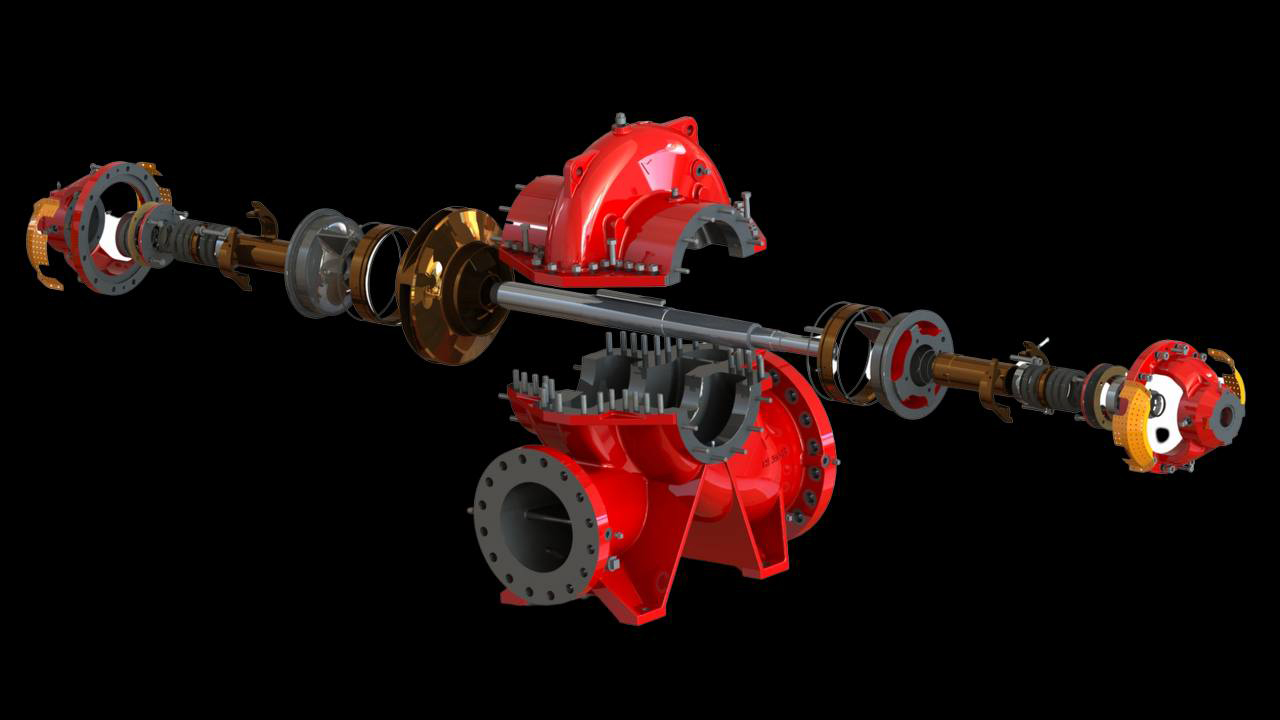
Pumps are essential elements in the life and comfort of human beings. Pumps move fluids whether they are hot or cold, clean or dirty. They perform this operation extremely efficiently and in an environmentally friendly manner. In the field of plumbing and HVAC, centrifugal pumps are used in a wide variety of applications. They differ in design and operation. Due to their design and operation, centrifugal pumps generate hydraulic power. Although there are many types of centrifugal pumps, a common feature of all centrifugal pumps is that the fluid enters an impeller axially.
With a maximum operating capacity of up to 20,000 m3/h our split case centrifugal pumps offer high performance with more simplified maintenance. Firepump.AI supports a full range of firepumps. Each pump model is best suited for a particular purpose, building type, and size.
What is a split case pump?
A split case pump is a type of pump whose casing is slotted perpendicularly or radially to the shaft in order to provide an easy access to the pump’s internal parts for simple maintenance. The term is widely used and refers to a double suction pump (or a pipeline pump) with an impeller that is designed to produce a high flow rate. Split case pumps can be either vertical or horizontal in design. Because of their size, these pumps are generally easier to maintain and service when the units are horizontal in design, as the motor does not have to be removed to service the pump. A horizontal split case pump is a unique type of centrifugal pump with the casing divided into two separate chambers, which is different from inline or end suction pumps that are assembled with the suction nozzle, discharge nozzle and casing in a single chamber.
Radially split casing pumps are quite different from other pumps in that the pump casing opens across or perpendicular to the shaft. They are generally designed to be pulled out from the back, which means that to service, the motor must be disconnected and the parts pulled out of the pump. This robust yet simple design is particularly suited to high flow applications as it reduces thrust loads and allows operation over a wide capacity range with minimal energy consumption, low maintenance costs and extended operating life.
Principle of a centrifugal split case pump
A pump has the following key components: a pump casing, impeller, rotating assembly a coupling and motor fixed on a baseplate. The main functional component of each centrifugal pump is an impeller located on a special shaft in a spiral housing. Such a pump works by the action of the centrifugal force. A motor drives the pump shaft on which the impeller is housed. The fluid enters the working casing in the axial direction. The water that enters the impeller axially through the suction flange and the suction neck is deflected by the impeller blades in a radial movement.
As the blades rotate, the fluid is pressed against the walls of the housing and then exits under pressure through the injection hole. The centrifugal forces that affect each particle of the fluid cause an increase in velocity and pressure as the water flows through the vane area. At the point where the water enters the pump, the pressure level decreases and in the area of the impeller, it increases. The main functional feature of a centrifugal pump is the possibility of a continuous water supply.
Operation of a horizontal centrifugal split case pump
The basic principle of operation of a centrifugal pump is based on the continuous pumping of a fluid through a suction nozzle which is located in the centre of the impeller. In the radial direction, the fluid will flow towards the edge of the impeller and once drained, the flow moves towards the casing. The impeller blades in turn transmit acceleration, so the liquid gains energy. However, once it reaches the casing, the fluid slows down and the kinetic energy is converted to pressure energy. This is ensured by an extremely tight seal in the cover.
Technology of horizontal centrifugal split case pumps
The main part of their working mechanism is a rotating impeller mounted on a shaft inside the housing. Our split case pump is based on single double suction or two single suction impellers in order to create consistent water pressures when needed. The casing is split axially, with opposing suction and discharge flanges, which greatly simplifies the maintenance. A permanent rigid alignment is performed in these pumps to eliminate the need for all other alignments. This extends the life of the seals and bearings. Our split case pumps feature a heavy shaft and a short bearing span that reduces shaft deflection to a minimum and also provide a longer packing and bearing life together with reduced maintenance costs, while requiring less floor space. Split Case listed FM and or UL liste fire pumps are available for duties ranging from 200 USgpm to 5,000 USgpm. These pumps are suitable for electric or diesel drives and are available with either inch or metric fittings. They are listed by Underwriters Laboratories (UL) and approved by Factory Mutual (FM)
Advantages of horizontal centrifugal split case pumps
Centrifugal pumps have many advantages, which make them very popular. Horizontal centrifugal pumps are designed to operate under very difficult and constant conditions. In general, one of their main advantages is that they are less expensive than vertical pumps, together with their simplicity of design and reliability of operation. They are also fairly easy to maintain and install, and disassembly can be done without moving the motor. The fluid can be drawn into the pump from a great height.
Features of horizontal centrifugal split case pumps
They have a relatively high number of shaft revolutions which makes it possible to use electric motors and diesel engines as mechanisms for rotation. The possibility of gradual reduction or increase of power is also an asset. Because of this quality, the unit can be started with the valve closed. When several pumps are installed in the same pipeline, the pressure level and the intensity of the water supply increase considerably. It is also possible to use an automated control system.
Configuration of Firepump AI split case pumps
Our split case fire pump models FR /TD/iHT/SCT series provide a flow from 150 to 5000 US gpm with a pressure up to 370 psi and with a speed of 1480 to 3550 rpm using a diesel and electric drive.
Benefits of Firepump AI split case pumps
Our pumps are approved, reliable and designed for maximum safety. They have served as the highest quality, long lasting fire pumps in the industry. Their maintenance is highly simplified thanks to opposing suction and discharge flanges within the axially split casing. This significantly reduces the radial thrust component. As for the efficiency of a horizontal centrifugal pump, to find out the coefficient, the hydraulic power must be divided by the power supplied to the pump shaft. In this way, we obtain the percentage of power transmitted to the fluid in relation to the total. The efficiency of horizontal centrifugal split case pumps is between 60 to 90%.
Applications of Firepump AI split case pumps
Today, such devices are used in various fields of activity. Split case pumps are the right choice for a wide range of applications such as water supply, irrigation, desalination, water treatment, pressure boosting, heating, air conditioning, firefighting, utilities and cooling water circulation in general industries. Our split case pumps are specifically designed for firefighting. They can be used as a sprinkler system, hydrant system, deluge system, monitor system and water curtains. They have been tested for fire departments around the world and are commonly used in offices, buildings, warehouses, industrial facilities, hospitals, airports, power plants, schools and colleges, hotels, etc.







